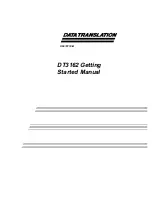
402-00005-00
Theory of Operation
2–18
Rev 02; February 8, 2002
optimal positive reference (PREF) setting is 3.25 Volts (register value 0xFC1). The optimal negative reference
(NREF) setting is 1.75 Volt (register value 0x87C).
The absolute minimum difference between any PREF and NREF combination is 0.4 Volt. The absolute maximum
difference between any PREF and NREF combination is 1.6 Volts. For best performance and accuracy, the differ-
ence between NREF and PREF should be 1.5 Volts.
Many “RS170 compatible” cameras output higher video levels, sometimes 800 mV or higher. In this situation, the
video signal after the 2.1 gain is larger than 1.5 V and saturates the ADC, which in turn does not use the full dynamic
range available (0 to 4096). You should calibrate the PREF and NREF for the dynamic range of the video signal you
are using, without exceeding the 0.4 to 1.6 Volt range of the ADC.
All reference DACs of the PCVisionplus are programmed through a serial interface. Refer to the DAC registers and
programming information in Chapter 4.
2.5.8 Input LUT
The Input LUT is a 64K-by-16 (16-bit in 16-bit out) SRAM. The Input LUT can be programmed to perform any point
transformation function.
The bit order is reversed at the LUT input. ADC output bit 11 is connnected to LUT input bit 0. The Oversample
Enable bit (OVRSM) controls the input LUT configuration, which has a great affect on how the LUT is programmed.
The Input Data Format bit (INMODE) controls how data is read from the LUT output, and packed and stored in the
image memory. The LUT must compensate for the data input format, bit ordering, and both OVRSM and INMODE
values.
In normal mode, the input LUT has 16 pages that are statically selected by register values under program control. The
LUT does not provide a dynamic page mode (page switching under pixel data control). In oversample mode the LUT
does not use the static page select.
With oversample disabled (OVRSM=0), the Input LUT provides sixteen pages for 16-bit input addressing, 12 bits
from the ADC and four page select bits, as shown in Figure 2–18. You can load up to 16 different 12-bit data trans-
forms and use the page select bits ILUTSADR (input LUT static address) to change transforms without reloading.
In 12-bit input mode (INMODE=1) all 16 LUT output bits are read and stored as a WORD in the image buffer
memory, as shown in Figure 2–18. The LUT can be programmed for any point transformation, normalization, or data
shift. The user must be aware that the Bus Master Controller pad, zoom, decimate and byte shift modes assume valid
pixel data is positioned on bits 11 through 0. Bits 15 through 12 are usually treated as “don’t care” values, but may be
useful as tag values.
Artisan Technology Group - Quality Instrumentation ... Guaranteed | (888) 88-SOURCE | www.artisantg.com
















































